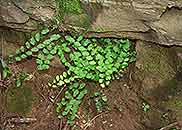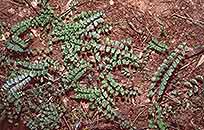Adiantum mendoncae Alston
Synonyms |
|
|---|---|
Common name |
|
Description |
Rhizome short, erect; rhizome scales dark brown. Fronds monomorphic, tufted, herbaceous. Stipe up to 15 cm long, dark brown, hairless except for narrow, hairlike scales towards the base. Lamina pinnate, narrowly lanceolate to oblong in outline, 30 × 5 cm, excluding a glabrous extension of the rhachis of varying length, which often ends in a proliferous bud or lamina with a terminal pinna; pinnae numerous (up to 20 pairs), alternate, broadly obcuneate to roughly obtriangular in outline, with thin dark brown petiole up to 7 mm long, 2 × 1.4 cm, reduced in size towards the apex, margin of the sides entire, outer margin convex and finely toothed; venation flabellate; rhachis, petiole and pinnae glabrous. Sori on apices of the outer pinna margin, indusial flap short, dark brown, hairless. |
Notes | A. mendoncae is pinnate, has a rhachis that is not hairy and long petiolules. It resembles and A. lunulatum, which has more semi-rounded pinnae with lobed margins. A. soboliferum has a stipe and rhachis that are winged. |
Derivation | mendoncae: the plant was collected by Francisco d' Assensão Mendonça in Mozambique in 1942. |
Habitat | Terrestrial or lithophytic, shaded earth banks in ravines, cliff faces, around boulders, in riverine fringes or Brachystegia woodland. |
Distribution worldwide | See African distribution. |
Distribution in Africa |
|
Growth form |
Lithophytic, terrestrial. |
Literature |
|

